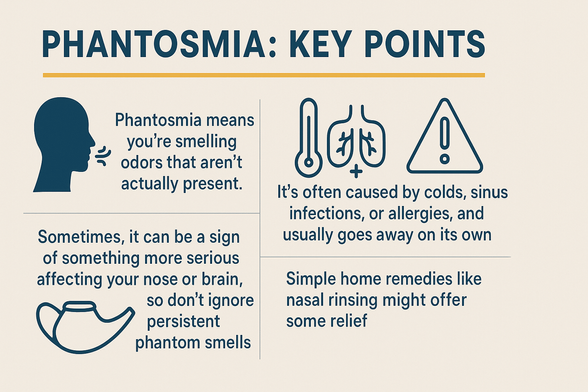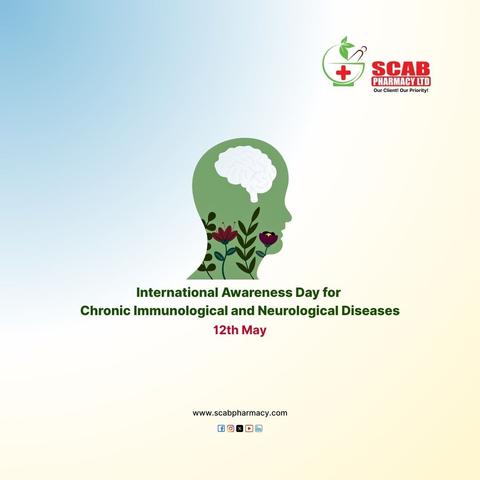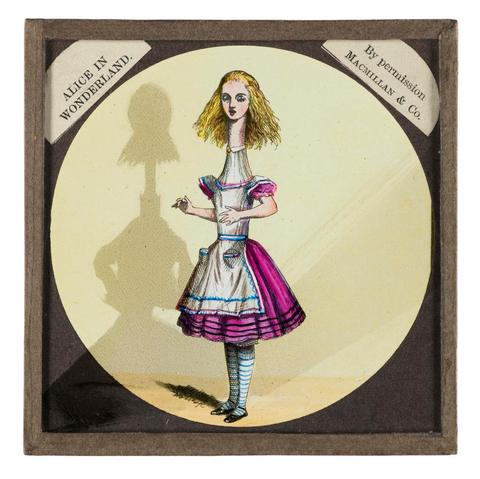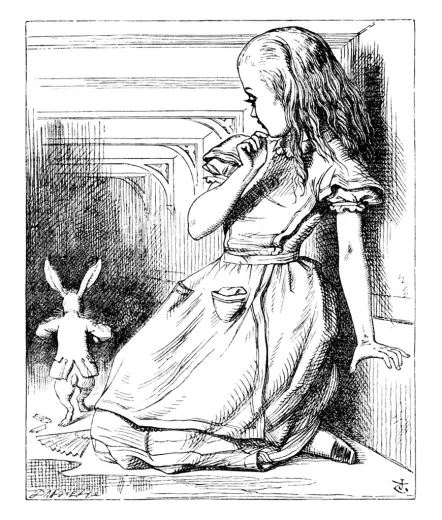Imagine this: you’re relaxing at home, maybe reading a book, and suddenly… a whiff of something burning. Like toast left too long in the toaster. You jump up, check the kitchen. Nothing. #COVID19smellloss #nasalpolyps #NeurologicalDisorders #olfactoryhallucinations #phantomsmells #phantosmia #SinusInfection
The following hashtags are trending across South African Mastodon instances:
#cartoons
#relationships
#humour
#amreading
#cindawareness
#chronicillness
#immunologicaldiseases
#neurologicaldisorders
#me_cfs
#fibromyalgia
Based on recent posts made by non-automated accounts. Posts with more boosts, favourites, and replies are weighted higher.
The following hashtags are trending across South African Mastodon instances:
#amreading
#southafrica
#Wordle
#wordle1423
#scabpharmacy
#cindawareness
#chronicillness
#immunologicaldiseases
#neurologicaldisorders
#me_cfs
Based on recent posts made by non-automated accounts. Posts with more boosts, favourites, and replies are weighted higher.
𝗜𝗻𝘁𝗲𝗿𝗻𝗮𝘁𝗶𝗼𝗻𝗮𝗹 𝗔𝘄𝗮𝗿𝗲𝗻𝗲𝘀𝘀 𝗗𝗮𝘆 𝗳𝗼𝗿 𝗖𝗵𝗿𝗼𝗻𝗶𝗰 𝗜𝗺𝗺𝘂𝗻𝗼𝗹𝗼𝗴𝗶𝗰𝗮𝗹 𝗮𝗻𝗱 𝗡𝗲𝘂𝗿𝗼𝗹𝗼𝗴𝗶𝗰𝗮𝗹 𝗗𝗶𝘀𝗲𝗮𝘀𝗲𝘀 – 𝗠𝗮𝘆 𝟭𝟮
Today we recognize the challenges faced by those living with Chronic Immunological and Neurological Diseases (CIND) such as ME/CFS, Fibromyalgia, Parkinson’s, and more. This day, marked on Florence Nightingale’s birthday, raises awareness to reduce stigma, promote early diagnosis, and encourage research and policy change.
Let’s support patients with sensitivity, spread knowledge, and contribute to better care and understanding.
#CINDAwareness #ChronicIllness #ImmunologicalDiseases #NeurologicalDisorders #ME_CFS #Fibromyalgia #ParkinsonsAwareness #HealthAwareness #SupportPatients #EndStigma #SCABPharmacy
Exploring the Curious Nature of Alice in Wonderland Syndrome
Alice in Wonderland Syndrome (AIWS) is a neurological condition that impacts an individual’s perception of their surroundings. This altered perception is thought to be related to the functioning of specific brain regions, including the occipital lobe, which is responsible for visual processing, and specific pathways that interpret spatial orientation and size perception.
My Story
Magic lantern slide depicting Alice’s Adventures in Wonderland, Alice with a Long Neck by Tenniel, Sir John 1820-1914; MacMillan and Co; York and Son is licensed under CC-BY-NC-SA 4.0Alice in Wonderland is one of my favorite books. Yet, I never thought I’d be trapped within the story itself, living out an experience so surreal and disorienting that it often feels like stepping into the pages of a fantasy novel. I wanted to share some information about this rare disorder, as it has become an increasingly frequent part of my existence, significantly impacting not just my physical health but also my daily life and relationships as well. Alice in Wonderland Syndrome, a condition characterized by distorted perception, is a curious feature of my migraines and is frequently the first indication that a migraine is imminent, often serving as a harbinger of the overwhelming symptoms that follow. This syndrome usually manifests as surreal alterations in my visual and spatial perception, making familiar surroundings appear strange and unrecognizable, as if I were trapped in a dreamlike state where nothing feels quite right.
Curious Symptoms
At times, I sense myself much taller than the items around me, creating a disconcerting feeling that alters my understanding of reality, turning mundane objects into towering giants or diminutive figures. Hallways become optical illusions where the floor warps off into the distance, and the dimensions of rooms seem to shift and change, leading to confusion and discomfort as I navigate spaces that should feel safe and familiar. The effect is akin to walking through a distorted mirror, where reality bends and twists in ways that leave me questioning my senses. While this condition has undoubtedly added complexity to my experiences, understanding it better has allowed me to manage my symptoms more effectively, empowering me to navigate through the challenges it presents on a daily basis with greater awareness and resilience, finding small moments of clarity amidst the chaos of perception.
Managing Symptoms
I have learned to recognize potential triggers, such as stress and fatigue, and employ coping strategies, including mindfulness techniques and relaxation exercises, which have been instrumental in reducing the frequency and intensity of my episodes. I decided to share information because this last week has been a rollercoaster of symptoms, including Alice in Wonderland Syndrome and intense vertigo, causing me to spend most of the week on the couch, grappling with waves of confusion and fatigue that made even the simplest tasks feel daunting. This experience has highlighted the importance of support networks and the necessity of reaching out to others who may understand these struggles, as it can make a significant difference in managing the emotional toll that accompanies such a rare condition.
Alice In Wonderland Syndrome: The Basics
Alice in Wonderland Syndrome, also known as Todd’s syndrome, is a fascinating and complex neurological condition that can lead to various unusual perceptual distortions. Those affected may experience significant distortions in their visual and spatial awareness, primarily manifesting through micropsia and macropsia. These distortions cause objects to appear significantly smaller or larger than they are, leading to a bewildering perception of the surrounding world. Micropsia refers to the unsettling perception of objects as smaller than their actual size. It can create a sense that one is in a distorted reality where familiar environments take on an eerie, surreal quality. On the other hand, macropsia involves the opposite experience, where objects seem much larger than they truly are, contributing to confusion and disorientation. Individuals experiencing these symptoms often find it challenging to navigate their environment, as their brain struggles to reconcile these discrepancies in size. Additionally, the effects of Alice in Wonderland Syndrome can vary greatly from person to person, with some individuals only experiencing it in fleeting episodes, while others may face more persistent challenges that significantly impact their daily lives. Understanding this syndrome is crucial, as it sheds light not only on the peculiarities of human perception but also on the underlying neurological mechanisms at play.
My Experience in Wonderland
I experience both microspia and macrospia; it is disorienting and hard to explain to doctors who might not be familiar with these phenomena. Before I knew it was called Alice In Wonderland syndrome, I’d try to describe what I felt to my doctors as being in a surreal world, kind of like Alice in Wonderland, where regular objects seem smaller or larger than they should be, which creates a confusing and often unsettling view of reality. It can feel like I’m stuck in a warped dream, where everything around me shifts and bends, making me question what’s real and what’s not. Many times, I’ve compared the sensations to being on a hallucinogen like LSD, caught in this vibrant yet confusing kaleidoscope of visual distortions, turning each doctor’s visit into not just a medical check-up but a real struggle to explain what I’ve been going through.
Neurological Mechanisms Underlying Microspia and Macrospia
Microspia and macrospia are visual distortions that are thought to be linked to the functioning of specific brain regions. The primary neurological mechanisms involve:
- Occipital Lobe Function: This area of the brain is responsible for visual processing. Disturbances in this region can lead to altered perceptions of size and spatial awareness.
- Pathways for Spatial Orientation and Size Perception: These neural pathways interpret visual stimuli, and any disruption in their function can cause objects to appear significantly smaller (microspia) or larger (macrospia) than they are. The interplay between these pathways and the occipital lobe is critical to our understanding of how these distortions occur.
Specific Treatments for Managing Alice in Wonderland Syndrome
The most effective management strategies for Alice in Wonderland Syndrome focus on addressing the underlying conditions that may trigger episodes. Common treatment options include:
- Medications:
- Anticonvulsants: These can help reduce the frequency of episodes, especially if seizures are involved.
- Triptans: Often prescribed for migraines, they can alleviate symptoms associated with migraine-related episodes.
- Beta-blockers: Helpful in managing migraines and reducing the severity of episodes.
- Cognitive-Behavioral Therapy (CBT): This form of therapy can assist individuals in coping with accompanying anxiety or disorientation, helping them manage their symptoms effectively.
My Treatments
Currently I am on a preventative migraine treatment as well as two abortive medications. I typically haven’t had luck with preventative throughout my life; in fact, it’s been a frustrating journey, as I have been on over 10 different preventatives with no success whatsoever. Each experience was another trial, and I hoped for a miracle that never seemed to come. The most success I have had with controlling migraine and Alice in Wonderland Syndrome (AIWS) is with Triptans, which are medications that are derived from ergot, or the building block of LSD. This intriguing connection leads me to wonder if the overuse of these medications could contribute to side effects such as AIWS, which makes me cautious about my treatment choices moving forward. I consistently seek information and insights into the potential long-term impacts of these drugs, as understanding this could greatly influence my approach to managing my condition and improving my quality of life.
Comorbidities
Additionally, this syndrome is often associated with various conditions, including migraines and epilepsy. Migraines can trigger episodes, causing visual disturbances and alterations in perception during attacks, while epileptic seizures, particularly those originating in the temporal lobe, can also lead to similar perceptual distortions. AIWS for me typically occurs before or concurrent with my migraine attack, sometimes lasting for hours or days. Other conditions, such as psychiatric disorders, certain infections, and substance use, can contribute to the onset of these symptoms, highlighting the complexity and interplay of different neurological and psychological factors involved in Alice in Wonderland Syndrome.
Long-Term Effects Associated with Recurrent Episodes
Although the episodes may be transient, recurrent occurrences of Alice in Wonderland Syndrome can lead to long-term effects, including anxiety, altered perception of reality, or a heightened sensitivity to visual stimuli. Sufferers might feel unusually detached from their body or surroundings, resulting in a unique and often disorienting experience of the world around them. Furthermore, this syndrome can influence how the passage of time is perceived; those affected may feel as if it is moving faster or slower than it is, similar to the whimsical alterations in reality experienced by Alice in the classic tale. This can result in confusion and disorientation, as everyday moments may seem stretched or condensed, further contributing to the overall surreal nature of the syndrome.
Recurrent episodes of Alice in Wonderland Syndrome can lead to several potential long-term effects, including:
- Persistent Anxiety: People may experience heightened anxiety due to the unpredictable nature of their episodes and their disorienting symptoms, which can lead to a constant state of worry about future occurrences, further impacting their daily lives and mental health as they struggle to navigate social situations and personal relationships while feeling on edge.
- Altered Perception of Reality: Long-term exposure to these distortions can shape how individuals view their surroundings, potentially leading to persistent changes in perception that affect their daily interactions, thought processes, and emotional responses, resulting in a comprehensive transformation of their worldview and lifestyle.
- Heightened Sensitivity to Visual Stimuli: Repeated episodes may cause individuals to become more sensitive to visual inputs, thereby enhancing the surreal experience of their environment, as they begin to notice subtleties and details that were previously overlooked, resulting in a profound alteration of their perception of reality.
- Detachment from Surroundings: Some individuals may feel a lasting sense of disconnection from their bodies or surroundings, influencing their overall perception of reality. This can manifest as a peculiar awareness where a person perceives their left side as detached from the right side of their body, leading to feelings of imbalance or disorientation. Such disconnection may create a sense that one side operates independently, adding to the overall sense of alienation and affecting their spatial awareness and motor functions.
- Perception of Time: Affected individuals might continue to feel that time is moving at an unusual pace, either faster than usual or slower than what is typically experienced. This contributes to ongoing confusion and disorientation in their daily activities, which can lead to difficulties in planning and executing tasks effectively.
In terms of prevalence, it is considered rare, affecting a small percentage of the general population, predominantly children and adolescents. With the right support and management, people can often navigate their symptoms and improve their quality of life.
Lifestyle Changes and Preventive Measures for Alice in Wonderland Syndrome
People experiencing Alice in Wonderland Syndrome may consider implementing the following lifestyle changes and preventive measures to help reduce the frequency of episodes:
- Stress Management: Engaging in stress-reducing activities such as yoga, meditation, or mindfulness can help mitigate triggers. Developing effective coping strategies for stress can lead to fewer episodes.
- Regular Sleep Schedule: Maintaining a consistent sleep pattern is crucial. Sleep disturbances can trigger episodes, so prioritizing quality sleep can help in managing symptoms.
- Healthy Diet: A balanced diet rich in nutrients may aid in overall neurological health. Staying hydrated and avoiding excessive caffeine or alcohol can also be beneficial, as these substances might trigger migraines or visual disturbances.
- Routine Exercise: Regular physical activity can contribute to overall well-being and reduce stress, which may help lessen the frequency of episodes. Gentle exercises like walking, swimming, or yoga are often recommended.
- Avoidance of Triggers: Identifying and avoiding specific triggers—such as certain foods, environmental factors, or activities that stimulate visual distortions—can be beneficial. Keeping a journal of episodes can help in recognizing these patterns.
- Regular Medical Check-Ups: Maintaining regular consultations with healthcare professionals can ensure proper management of underlying conditions (like migraines or epilepsy) that might contribute to Alice in Wonderland Syndrome.
- Medication Management: Adhering to prescribed medications and discussing any changes in symptoms with a healthcare provider can help in managing episodes more effectively.
- Cognitive-Behavioral Techniques: Learning coping techniques through therapies, such as Cognitive Behavioral Therapy (CBT), can be beneficial in managing anxiety and disorientation associated with episodes.
Challenges of Lifestyle Changes
Implementing these lifestyle changes can empower individuals to take control of their health and potentially reduce the frequency of episodes associated with Alice in Wonderland Syndrome. However, I’ll be honest—it’s almost impossible to implement some of these actions during a flare. Exercise? I think not, unless I want to vomit, as my body feels heavy and unresponsive, making even the thought of movement exhausting. Sleep and a healthy diet are crucial, yet I find it challenging to maintain consistency. I guess the Valium helps with sleep and reduces the vertigo for a few hours, but it doesn’t entirely alleviate the underlying issues. I’m grateful for my husband’s support; he cooks me a healthy dinner when I can’t muster the energy to prepare myself. In these moments, I realize how fortunate I am to have someone to rely on. In this respect, I’m lucky—if I lived alone, I don’t think I would be functioning as well. The emotional toll of these symptoms can be disheartening, and having a partner who understands and helps makes a significant difference. It reassures me that I’m not facing this battle alone and that support can play a pivotal role in managing my condition effectively.
Photo by cottonbro studio on Pexels.comMoving Forward (Cautiously)
Navigating life with Alice in Wonderland Syndrome presents unique challenges that can feel isolating and bewildering. However, we can better equip ourselves to face its complexities by fostering a deeper understanding of this condition, sharing personal experiences, and implementing effective management strategies. It is important to remember that support from loved ones and the wider community plays a crucial role in our journey. As we share our stories and connect with one another, we empower ourselves and help demystify this rare condition for others. Together, we can embrace our experiences, find solace in our shared struggles, and inspire resilience in the face of uncertainty.
For more information, please visit the Cleveland Clinic webpage on AIWS or the research article at NIH
Additionally, there is a Facebook support group for AIWS found here. The Brain Charity is a support group based in the UK.
Do you suffer from Alice in Wonderland Syndrome? I would love to hear your story because sharing experiences can be incredibly cathartic. When we talk about what we go through, it not only helps us personally but also connects us with others who might be facing similar challenges. Understanding that we are not alone in our struggles can be vital to healing. Every story is unique, and by sharing, we can create a supportive community where we can learn from one another and find comfort in the shared journey. Your voice matters, and together, we can navigate this intriguing, yet often bewildering, condition.
#AliceInWonderlandSyndrome #balance #experience #healing #meditation #migraine #mindful #mindfulness #moments #neurologicalDisorders #perception #practice #vertigo

Magic lantern slide depicting Alice's Adventures in Wonderland, Alice with a Long Neck | Science Museum Group Collection
Hand-painted glass lantern slide illustrating scene from 'Alice's Adventures in Wonderland' by Lewis Carroll. Illustrations by Sir John Tenniel, made by York and Son, published with permission of MacMillan and Co, 1880s. Slide number 4 shows Alice with an elongated neck.
It was one of those crisp, breezy mornings at the local market. The scent of fresh produce mixed with the sounds of cheerful chatter. #AgingPopulation #Alzheimer’sDisease #brainhealth #caregiversupport #cognitivedecline #dementia #DiagnosisofDementia #EarlyDementiaSigns #elderlycare #FamilyHealth #memoryloss #mentalhealth #NeurologicalDisorders
I'm really fascinated by how you can do good for people with sounds and music. It's truly an incredible journey to approach this from a scientific perspective. So fascinating...
"The Role of Music in Supporting Individuals with Neurological Disorders" (some basic things and further readings)
#MusicTherapy, #NeurologicalDisorders, #Neurology
It's wonderful to have music as a tool and to be able to work with it. ❤ Am I right, colleagues #musicians ? 😁
*The Role of Music in Supporting Individuals with Neurological Disorders *
Good morning, all! Just woke up, had breakfast, and now I'm sipping re-heated coffee from last night's pot. Today's agenda: a neurologist appointment for nerve block injections to manage my #OccipitalNeuralgia. It's a mix of dread and anticipation - painful procedure, but months of relief make it worthwhile.
This round wore off early due to a brief gap in my medication, but I'm hopeful for better results this time.
On the learning front, I'm diving into lesson 13 of my #BrailleProofreading course after receiving feedback on lesson 12. Also on the to-do list: finishing a #freeCodeCamp #JavaScript project - a #Pokémon search app. I've been procrastinating a bit because JS can be challenging!
How's everyone else's day shaping up?
#ChronicPain #DisabilityLife #CodingJourney #Accessibility #NeurologicalDisorders





